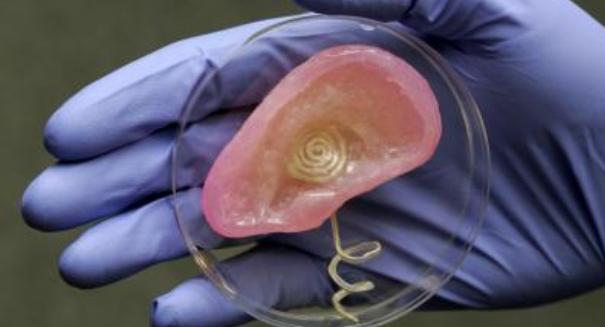
Once printing was completed, the ear was soft and translucent.
One of the most difficult biological structures to surgically reconstruct is the ear. However, a team of Princeton researchers, led by assistant professor of mechanical and aerospace engineering Michael McAlpine, successfully used a 3-D printer to create a bionic ear.
McAlpine told USA Today that the end result wa a small step, but the work could lead to a digital sixth sense for humans in the near future, enabling the body to connect to electronic devices.
The research team used the 3-D printer to construct a scaffold of cells, and hydrogel and electronic nanoparticles of an antenna to construct a fully functioning ear capable of of registering frequencies beyond what a normal human ear has the ability to hear. The bionic ear contains both cartilage and a coil antenna. It was constructed using bovine cells and silicone mixed with silver particles. The silver particles are the component the printer uses to form the coil antenna which allows the ear to receive radio signals that are interpreted as sound.
Once printing was completed, the ear was soft and translucent. Ten weeks of cultivation gave the cells time to multiply, creating a fleshy color and forming hardened tissue around the coil antenna.
According to the university, 3-D printing has been used in the development and construction of many different personal and industrial objects, but an ear marks the first time the technology has been successfully used to create an organ comprised of both tissue and electronics.
The newly created bionic ear still requires further study and testing before it could be used on a patient, researchers told the Princeton Alumni Weekly. However, in the future it could be used for restoring or enhancing human hearing. The ear was not initially designed to replace a human ear, but rather an exploration of a new method of combining biological and electronic material in the field of cybernetics.
In the journal Nano Letters, researchers wrote, “This field has the potential to generate customized replacement parts for the human body, or even create organs containing capabilities beyond what human biology ordinarily provides.”
Leave a Reply